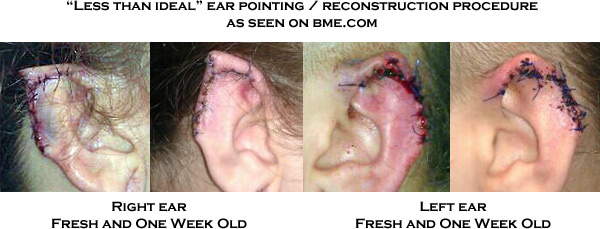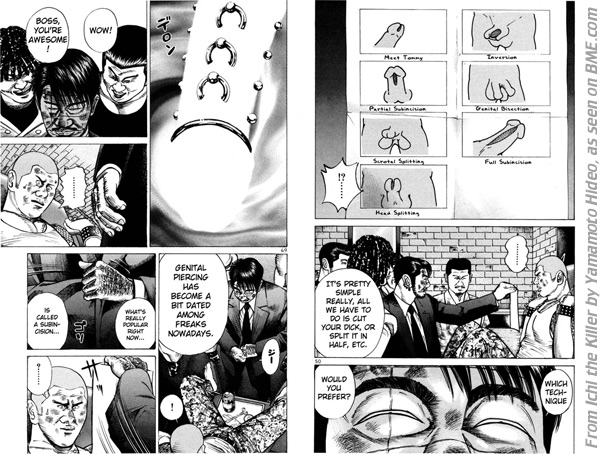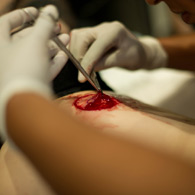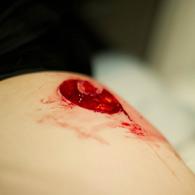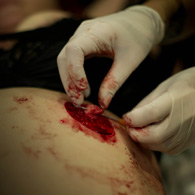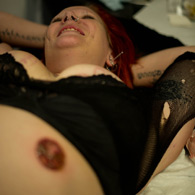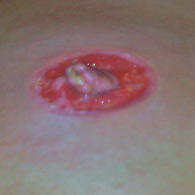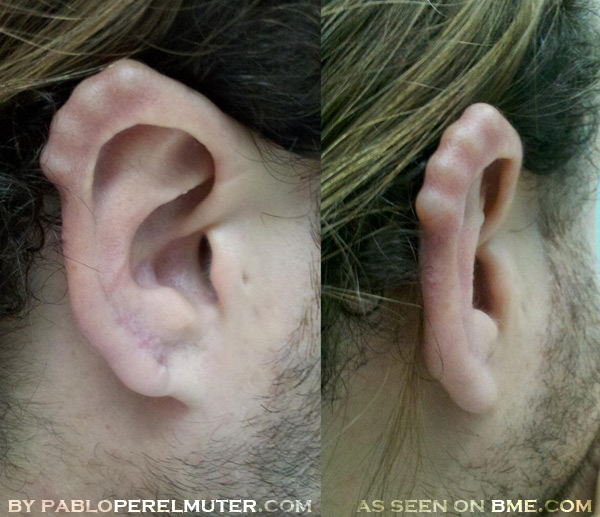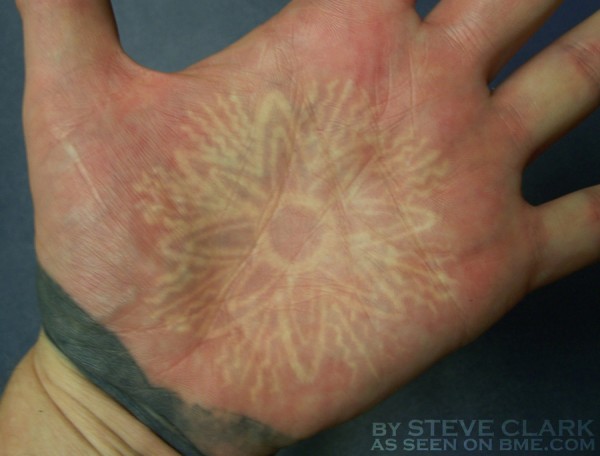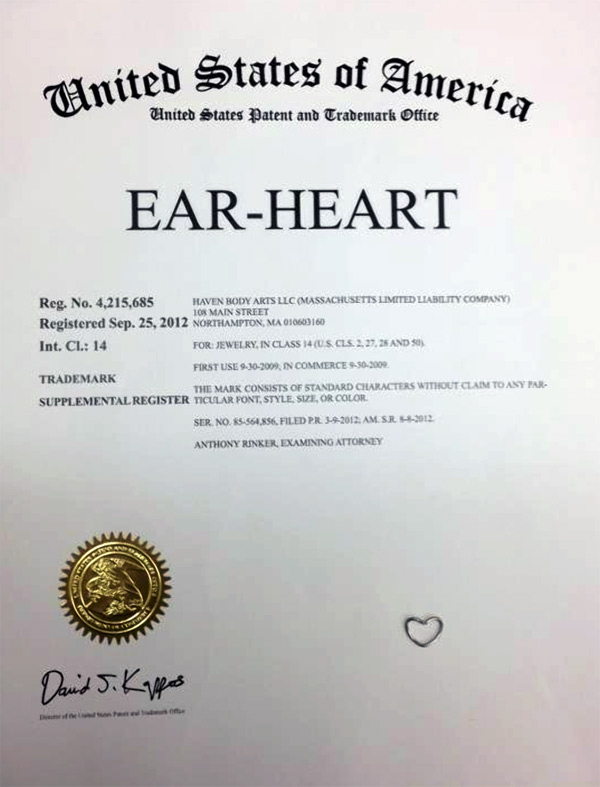I was reading the Ichi the Killer manga this afternoon and I was pleased to see what I’m quite certain is BME’s influence on it. Great comic and movie for anyone who enjoys the S&M side of body play, but I have to admit that I got a chuckle out of the Japanese interpretation of the word “meatotomy” — Meet Tommy. It’s like a codeword or something… “Pssst… have you met tommy?” I love it.
Monthly Archives: November 2012
Post navigation
Feminine Horns
In all honesty, the aesthetic of horn implants isn’t for me, but this pair is nice and subtle and seem to suit Rebecca Davis perfectly. It’s like she was born with them!
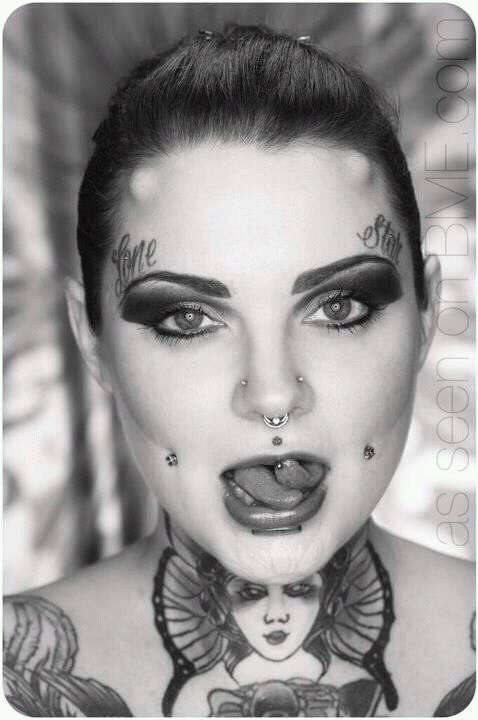
Generally horn implants are pretty noticeable, so I was curious what her reasoning was for going with something a little less bold.
“Well I wanted to start off small to see how I liked them. After they healed I realized that most people don’t notice them so I don’t get stopped that often by random people saying “wuts that in ur head!?”. I like that I can hide them if I need to, they are like a surprise!”
The implant procedure was performed by Tony Snow, and photography is by Marshall Bradford.
Nipple Graft: New Nipples Anywhere!
I’m always very happy when I get to show the body modification world a new procedure that opens up new aesthetic options. So I am completely thrilled to show you an experimental first attempt at a nipple graft procedure coming out of South Africa’s small but inspired body modification community, done on Estè Kira by Lliezel Ellick and Faranaaz Kannemeyer (with most of the photos being by Lohan Koegelenberg). They learned a lot doing this, and I really want to be fair by mentioning that they’d originally wanted me to wait until they’d done a few more and refined the procedure before I showed it. But I think even this first attempt at creating a new nipple from regular skin is incredible and felt it was worth showing off — and I can’t wait to see their next attempt. Let me begin with a photo of the healed result, and then go on to the procedure in more detail.
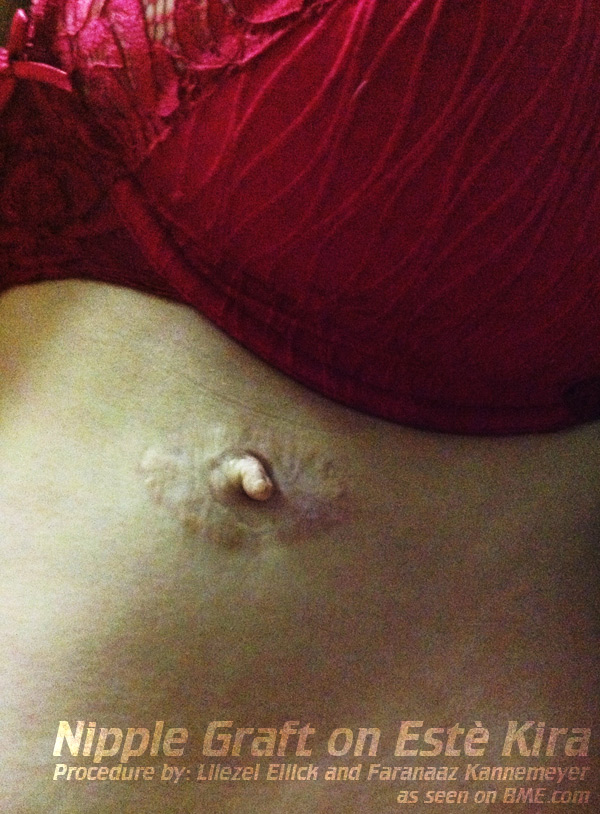
Estè tells me that about a year ago, while joking around with a friend, she started thinking about having multiple nipples grafted. She says, “I have always envied people with third nipples, and soon realized that it should be possible to create a nipple from skin. I researched nipple reconstruction procedures, usually used in mastectomy cases, and found a website with some pictures and illustrations of the procedure.”
“My close friend, piercer, fellow performer and body mod artist, Lliezel Ellick, was immediately keen to try this experimental procedure. Together with Faranaz Kamaldien, another Cape Town piercer and scarification artist, we got together one saturday morning. After a bit of brain storming, and me explaining to them how I understood the procedure to be done, we went ahead. A friend of mine filmed the procedure as well. It was by far the most intense experience I have had thus far. The over-the-counter anesthetic was not strong enough, so I felt most of it. Every now and again I had a look and we would discuss the next step. It was very deep with the yellow fatty tissue exposed. I kept the open wound closed for about one and a half months with daily cleaning. I think it was the very intense and long healing and a very hard and physical job that has kept me thus far from continuing with the other three that I have planned, but have some time off in December, and want to do them then.”
In December when they do the next three, giving Estè two rows of three nipples a piece, they will be doing some refinements to the procedure from what they learned doing the first one. To the best of Estè’s knowledge — and I agree with her — this is the first such procedure done in the body modification community. It’s extremely exciting to me, and I think they deserve a lot of credit for opening this door, to say nothing of having done it so successfully.
Below you can see the procedure. In the first picture you can see the skin being peeled up around the centre, and in the second photo the cutting/peeling has been completed. In the third photo the stitching is being done, and in the fourth (first photo of the second row), you can see what it looked like fresh and stitched up. Photo five — satisfaction! And in the last picture (which is just a phone photo), you can see it healing at two weeks into the procedure. The photo we began with above is the healed result. My hat is definitely off to Estè, Lliezel, Faranaaz for doing a wonderful procedure and expanding the body modification palette. Great work!
Red Eyes of Doom!
Mary Jo just had Brazil’s Rafael Leão Dias finish her other eye, injecting both of them with red… It’s an interesting color, because unlike tattooing your eyes black or green or just about any other color, no one is ever going to look at you and think you tattooed your eyes — in some ways it reminds me of the guy that got hyper-realistic road-rash tattooed on his face (one of the craziest things I’ve ever seen by the way) because she will forever be freaking out people on a whole different level than everyone else with tattooed eyeballs! I’m sure it’s both very fun and very tiresome dealing with the questions.
Red is perhaps the most volatile color of tattoo ink, so I’ll be keeping watch on how her eyes progress. One important thing to understand as well is that the majority of tattoo pigments — red especially — are not completely long-term stable in the body, so even when they appear safe in the short term, as they break down over time significant problems can occur since there’s no way to remove either the ink or any chemical compounds it breaks down into. If you get your eyes tattooed in your teens, that ink has to stay there for a long, long time still. I do think it looks stunning, but it’s not a gamble I’m comfortable with personally. Of course, it’s not as if my blue ink is considered safe for use in eyes according to the MSDS data either so my worry is a little hypocritical!
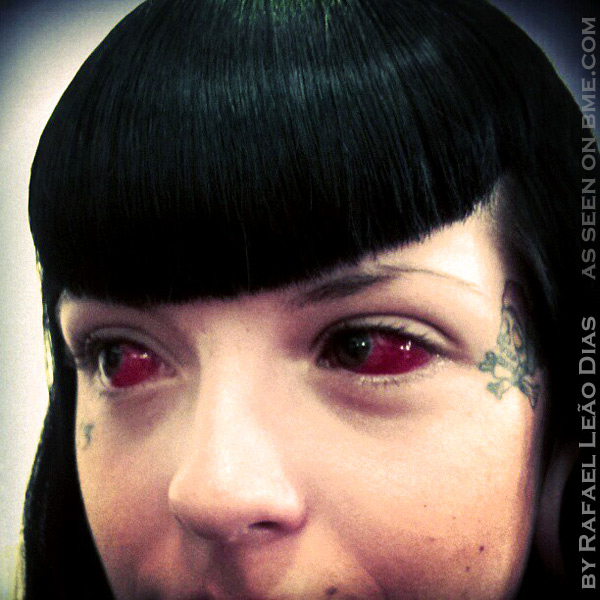
When tattooing with red ink, especially in the eye, it’s extremely important to be aware of what’s in the ink, because there are a variety of compounds that can create a red ink — iron oxide (rust basically), naphthol (arguably the safest option), pyrazolone (an organic compound), cadmium red (a toxic compound common to paint), and cinnabar (which is mercury based, and also toxic). Unfortunately sometimes because the more toxic compounds give a stronger color and sometimes because they’re cheaper, it’s not uncommon to find them in tattoo inks, although it’s becoming more rare. If you want to do some research for yourself, most higher quality red inks are a mix of Pigment Red 210 C.I.# 12477 (naphthol), Pigment Yellow 65 C.I. #11740 (2-[(4-methoxy-2-nitrophenyl)azo]-N-(2-methoxyphenyl)-3-oxo-Butanamide), Pigment Orange 13 C.I. #21110 (pyrazolone), and Titanium Oxide C.I. #77891, depending on the specific tone — as well as glycerine, witch hazel, various alcohols or even just listerine, various acrylic resins, and water. None of these compounds (with the exception of water) are considered safe in the eye — although they are generally stable compounds. The only ink which has been validated as truly “safe” in the eye is — and this may come as a surprise — classic India Ink.
And see also the Eyeball Tattoo FAQ of course.
Ear Ridge Implants
An alternative to the various ear pointing procedures that can give a person an entirely different sort of anatomical self-expression is using an implant to augment the outer helix ridge/fold of the ear. In this example, Pablo Perelmuter (pabloperelmuter.com) of Buenos Aires, has placed a what looks like a set of four beads but is actually a single 6mm silicone bead string manufactured by Steve Haworth — using a single piece like this ensures there will be no shifting and the placement will stay perfectly spaced (and they’re quite soft and don’t tend to bother the wearer even in such sensitive placements). Pablo says that the procedure went well, although it became quite swollen initially. These healed pictures were taken at eight months.
Edit/Update: I should add that this implant ended up being removed two years later, because the person it’s on was in nursing school and had some concerns it could affect their career options negatively. The removal procedure was fast and simple. I really hope that people considering body modification procedure always have an “exit strategy”, because it’s quite common for life to change and for one to find oneself needing to “normalize” ones appearance — this is one of the reasons I worry so much when I see teenagers getting irreversible and socially daring procedures like eye tattoos.
13 Year-Old White Ink Palm Tattoo
Thirteen years ago Lee got his hand tattooed by machine in white ink by Steve Clark (currently working at Phoenix Tattoo Studio in Raleigh, NC). Palm tattoos are troublesome at the best of times, let alone when in white ink (it’s not so much that white ink is hard to heal — it’s just that it’s more difficult for the artist to work with in general), but as you can see, almost a decade and a half later this tattoo is still remarkably solid. There’s a little variance in line weight, perhaps from Steve hitting the hand harder than he’d normally hit a tattoo to make sure it stayed in place, but the important thing is that it’s there. The yellowing simply reflects Lee’s skin tone — even if the ink is pure white, skin isn’t clear glass (otherwise humans would be freaky walking anatomical-model nightmare fuel) so tinting of this type is normal.
No more heart-shaped jewelry allowed?!?!
As of September 25, 2012, Haven Body Arts LLC of Northampton, MA has a registered trademark for heart shaped jewelry called “ear-heart”. They are claiming first use as of September 30, 2009, presumably saying this was the invention. So… what do you think? Obviously this is a popular jewelry design that is being widely used all over the world and has been for some time, and “ear-heart” is an obvious but incredibly lame name. But who can show it being used before 2009?
I know that there are pictures in the BME galleries of it being used — ie. prior art — that is much older than late 2009 — for example, back in 2006 I posted this photo of John Lopez’s work. He was at Slave to the Needle in Seattle by the way. I’m sure I could come up with hundreds of others. I am sure some of them called it an ear-heart. I can’t stand jackasses who try and abuse patent and trademark and other intellectual property law.
Click the photo of the registration to see Reg #4,215,685 on Trademarkia.
Note: I should clarify that this trademark almost certainly doesn’t stop anyone for using jewelry of this design, it just stops them from calling it an “ear-heart”. Which is perhaps even sillier since these are such common and obvious words!
Second Generation Ear Pointing
At the start of October I posted about an ear pointing that Samppa Von Cyborg (voncyb.org) had done and included some fresh photos. I’m thrilled today to be able the healed result today, and it’s truly incredible. It’s not just an ear that’s been folded into a point at the top. It’s an ear that’s been completely rebuilt to give the illusion of having grown naturally into this form.
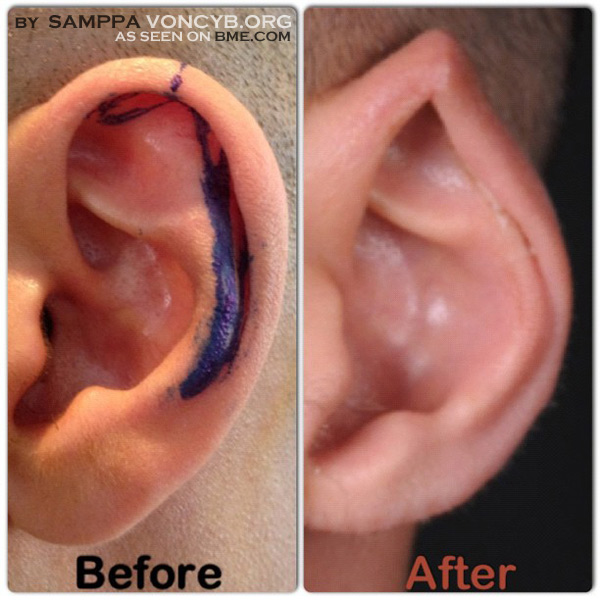
You may recall the ear pointing trainwreck posted about a month ago. It’s important to understand that the more complicated the procedure gets, the higher the risk of failure, both in terms of full-on failure, and aesthetic mistakes. This is very much the case with advanced ear pointing like this. I’ve been sitting on these pictures for a while, because I don’t have explicit permission to post them, so I’m cropping them more than I want to in order to hide the person’s identity (and really pointing fingers is not my goal), but they show an attempt to do this procedure leaving a customer with an ear that to me looks like the sort of thing a caveman might have after battling a sabretooth tiger. It’s definitely not as gnarly as some procedures-gone-wrong, but it falls far short of what a person should expect — for starters, in addition to the technical aspects of the procedure looking amateur, the aesthetics and angles are nonsensical, and the two ears don’t come close to matching.
I really want to urge clients to only go to people for work that they can show you multiple healed examples of in their portfolio. And practitioners, there is absolutely no excuse in today’s world for blindly copying procedures you’ve seen more experienced artists post online. Training is available. Take advantage of it. Take it slow. It’s better to be responsible practitioner than to be something akin to a jackass in a comment forum yelling “first”. You don’t want the weight of needlessly messing people up on your conscience. Just remember you’re playing with people’s lives. Do it for them, not for your ego.
